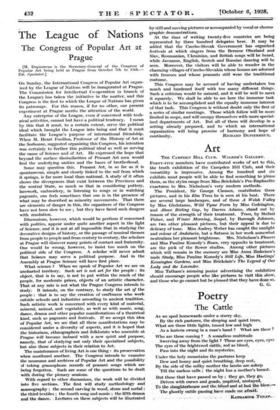The League of Nations
The Congress of Popular Art at Prague
[M. Dupierreux is the Secretary-General of the Congress of Popular Art being held at Prague from October 7th to 1 oth.— ED. Spectator.] ON Sunday, the International Congress of Popular Art organ- ized by the League of Nations will be inaugurated at Prague. The Commission for Intellectual Co-operation (a branch of the League) has taken the initiative in the matter, and this Congress is the first to which the League of Nations has given its patronage. For this reason, if for. no other, our present experiment at Prague merits the attention of the world.
Any enterprise of the League, even if concerned with tech- nical activities, cannot but have a political tendency. I mean by this that it must, to a certain extent, serve the political ideal which brought. the League into being and that it must facilitate the League's purpose of international friendship. When M. Henri Focillon, Professor of the History of Art at the Sorbonne, suggested organizing this Congress, his intention was certainly to further this political ideal as well as serving the cause of Science and of Art. He expressed the hope that beyond the surface dissimilarities of Peasant Art men would find the underlying unities and the bases of brotherhood.
Some may question this. Peasant Art, in so far as it is spontaneous, simple and closely linked to the soil from which it springs, is far more local than national. A study of it often shows the divergences that exist between the Provinces and the central State, so much so that in considering pottery, lacework, embroidery, in listening to songs or in watching pageants, one feels sometimes that one is in the presence of what may be described as minority movements. That there are elements of danger in this, the organizers of the Congress have not been slow to see ; but they have faced such dangers with resolution.
Discussions, however, which would be perilous if concerned with politics, appear under quite another aspect in the light of Science, and it is not at all impossible that in studying the decorative designs of history, or the passage of musical themes from people to people and from century to century, the scholars at Prague will discover many points of contact and fraternity. One would be wrong, however, to insist too much on the political side of the Congress. A scholar will never admit that Science may serve a political purpose. And in the Assembly at Prague Science will have first place.
What science ? When we speak of Popular Art we are on uncharted territory. Such art is not art for the people : its object, that is to say, is not to put within the reach of the people, for moderate prices, objects of an artistic character.. That at any rate is not what the Prague Congress intends to study. It intends, on the contrary, to study the art of the people : that is to say the creation of craftsmen who work outside schools and industries according to ancient tradition. Such artistic work ii concerned with every kind of material, mineral, animal, and vegetable, as well as with music, song, dance, drama and other popular manifestations of a theatrical kind, such as pageants and festivals. If we accept this idea of Popular Art, we see that all these manifestations may be considered under a diversity of aspects, and it is hoped that the historians, ethnographers and folklorists who assemble at Prague will become imbued with a new spirit and purpose, namely, that of studying not only their specialized subjects, but also those subjects in their relation to Art.
The maintenance of living Art is one thing : its preservation when moribund another. The Congresi intends to examine the museums and archives of Popular Art and the possibility of taking gramophone records of peasant songs which are being forgotten. Such are some of the questions to be dealt with during the plenary sessions.
With regard to other discussions, the work will be divided into five sections. The first will study methodology and museography ; the second carving in wood, stone and metal ; the third textiles ; the fourth song and music ; the fifth drama and the dance. . Lectures on these subjects will be illustrated by still and moving pictures or accompanied by vocal or chorea graphic demonstrations.
At the time of writing twenty-five countries are being represented by three hundred delegates here. It may be added that the Czecho-Slovak Government has organized festivals at which singers from the Bernese Oberland and Slav, Roumanian, Ukrainian, and British songs will be heard, while Javanese, English, Scotch and Russian dancing will be seen. Moreover, the visitors will be able to wander in the charming villages of Czecho-Slovakia whose houses are adorned with frescoes and whose peasants still wear the traditional costume.
This Congress may be accused of having undertaken ton much and burdened itself with too many different things. Such a criticism would be natural, and it will be well to meet it squarely. We shall be able to see here the immense task which is to be accomplished and the equally immense interest of that task. This Congress is without doubt only the first of a series of similar meetings. Those which follow will be more limited in scope, and will occupy themselves with more special- ized departments of Art. But all of them will develop in a setting already prepared, and to which an international organization will bring promise of harmony, and hope of






















































 Previous page
Previous page